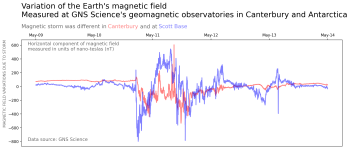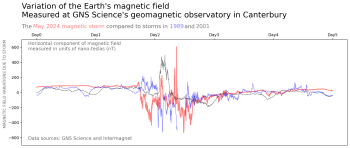
Solar storm causes beautiful skies and new data
The colourful skies awash with the Aurora Australis (Tahu-nui-a-rangi) witnessed by many throughout Aotearoa New Zealand over the weekend were caused by a geomagnetic storm or ‘solar storm’. Read on as we take a closer look at space weather and see how it’s recorded by our monitoring instruments across the country.
What is space weather?
Driven by the Sun, space weather occurs in the areas between the Sun and other planets in our solar system and tends to impact Earth much higher in the atmosphere than normal weather we experience.
During times of high activity, we can see what’s called coronal mass ejections (CME’s) from the Sun. These are highly energetic charged particles from the Sun’s magnetic field which are catapulted into space. When a CME reach Earth, it affects our magnetic field causing the auroras witnessed by many. These solar storms can also be referred to as a solar tsunami.
Although uncommon, large space weather events have occurred globally and in New Zealand in the past, causing electricity blackouts and damage to infrastructure. Solar storms send electric currents into the ground, that can, when large enough, potentially be very harmful to New Zealand’s power transmission system. Luckily, last week wasn’t as severe.
How do we record solar storms?
We continuously record changes in the Earth’s magnetic field at geomagnetic observatories using instruments that we call magnetometers. These magnetometers can record the rapid changes of the Earth’s magnetic field associated with solar storms, as well as other geologic processes. One of our observatories is located inland from Christchurch, and another one near Scott Base, Antarctica, recording the data since 1902 and 1957, respectively. GNS Science has been monitoring them through the GeoNet programme since 2001, alongside the Nationally Significant Collections and Database programme.
This weekend’s activity was observed at both Canterbury and Scott Base observatories, revealing how the Earths’ magnetic field varied at those locations.
Our long history of collecting geomagnetic observations let us compare the weekends activity to some space weather. This weekend's storm displayed magnetic field changes larger than the biggest space weather event of 2001 in our digital records. Professor Craig Rodger, from the Department of Physics, University of Otago commented that “this was not the extreme event we have all been preparing for. We expect that will be roughly 15 times larger than what we saw on Saturday night”.
To see the potential scale of an event like that, we can compare the 11 May 2024 activity to a much larger event in 1989. Data from which we have recently digitised as part of the Solar Tsunami Endeavour. The 1989 solar storm impacted power grids in North America and Europe. Satellite and radio communications were affected, and in Quebec, Canada six million people were without power for nine hours.
The future of space weather
The Solar Tsunami Endeavour Programme is an international collaboration led by the University of Otago, including experts from GNS, to understand how New Zealand’s energy infrastructure will be impacted by an extreme space weather event.
The research from this programme aims to find out how likely and big future storms could be, if they can be forecast and what impact they would have on our critical energy supply networks.
The geomagnetic observatory near Christchurch plays an important role in this research as it provides data not only from when the digital recording era started in 1991, but also from when geomagnetic data was captured on photographic paper. This long-term dataset allows researchers to learn from the past and develop models for the future that help collaboration partners like Transpower, to prepare and mitigate for extreme Space Weather events.
More information on the Solar Tsunamis project can be found here.
While everybody is looking up
It is neat to think how particles from the Sun can interact with gases in our atmosphere and give us such lovely scenes. And while everybody around the motu is gazing at the sky, GNS Science, Otago University and our other partners are measuring the other invisible impacts on Aotearoa New Zealand from these space weather events.
Media Contact: 021 574 541 or media@gns.cri.nz






